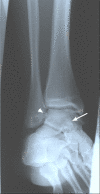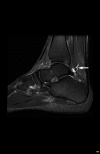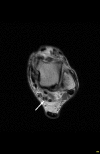A case report of bilateral synovial chondromatosis of the ankle
- PMID: 18036237
- PMCID: PMC2216021
- DOI: 10.1186/1746-1340-15-18
A case report of bilateral synovial chondromatosis of the ankle
Abstract
Background: Synovial chondromatosis is a rare, generally benign condition which affects synovial membranes. It most commonly involves large joints such as the knee, hip, and elbow, but its presence in smaller joints has also been reported. The diagnosis of synovial chondromatosis is commonly made following a thorough history, physical examination, and radiographic examination. Patients may report pain and swelling within a joint which is often aggravated with physical activity.
Case presentation: A rare case of bilateral synovial chondromatosis of the ankle is reviewed. A 26 year-old male presented with chronic bilateral ankle pain. Physical examination suggested and imaging confirmed multiple synovial chondromatoses bilaterally, likely secondary to previous trauma.
Conclusion: The clinical and imaging findings, along with potential differential diagnoses, are described. Since this condition tends to be progressive but self-limiting, indications for surgery depend on the level of symptomatic presentation in addition to the functional demands of the patient. Following a surgical consultation, it was decided that it was not appropriate to pursue surgery at the present time.
Figures







References
-
- Hocking R, Negrine J. Primary synovial chondromatosis of the subtalar joint affecting two brothers. Foot & Ankle International. 2003;24:865–7. - PubMed
-
- Yu GV, Zema RL, Johnson RWS. Synovial Osteochondromatosis. A case report and review of the literature. J Am Podiatr Med AssocJournal. 2002;92:247–54. - PubMed
LinkOut - more resources
Full Text Sources

